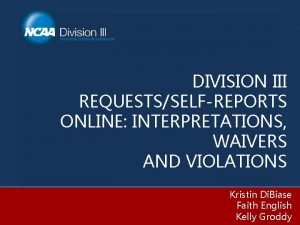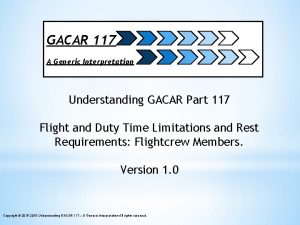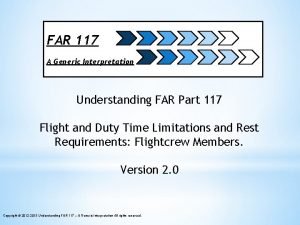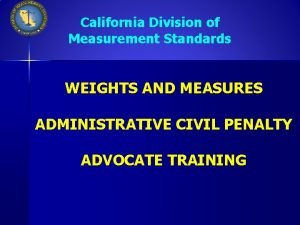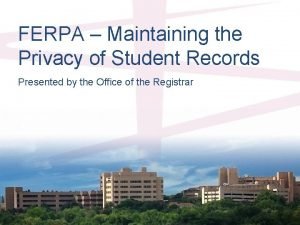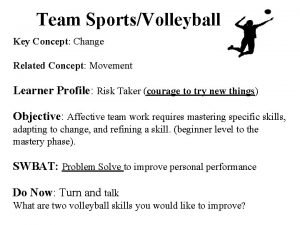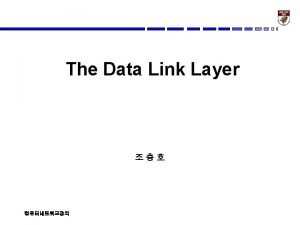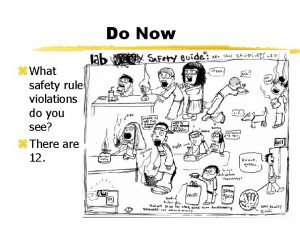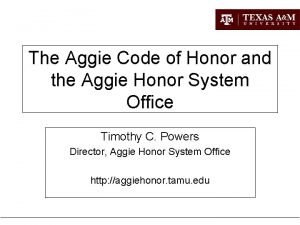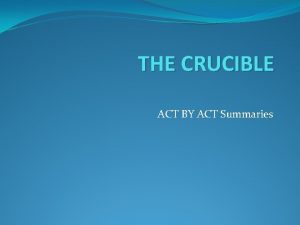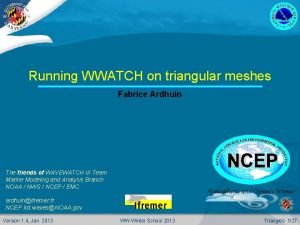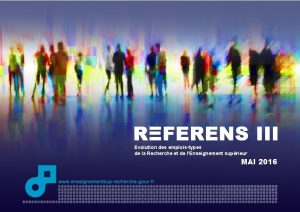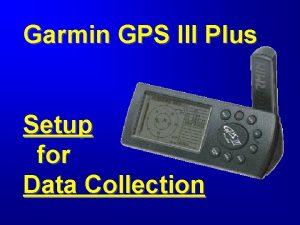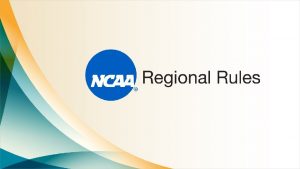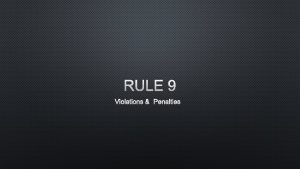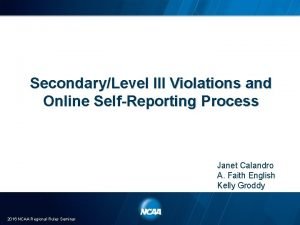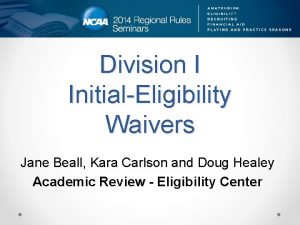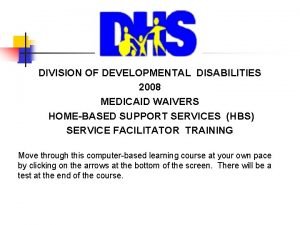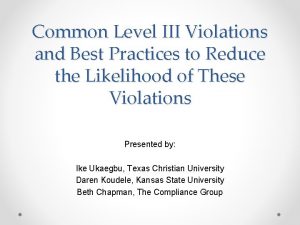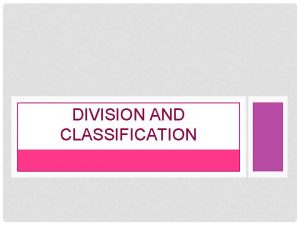DIVISION III REQUESTSSELFREPORTS ONLINE INTERPRETATIONS WAIVERS AND VIOLATIONS























































































- Slides: 87

DIVISION III REQUESTS/SELF-REPORTS ONLINE: INTERPRETATIONS, WAIVERS AND VIOLATIONS Kristin Di. Biase Faith English Kelly Groddy

Agenda What is RSRO? Navigating the system. Making your case. Filing a request or self-report. Interpretations submissions. Practice activity.

For the best learning experience, please go to ncaa. org in your browser now. Technical problems? My Apps and Single-Source Sign-On: ncaatechnology@ncaa. org RSRO: rsro@ncaa. org

WHAT IS RSRO?

What is RSRO? NCAA Requests/Self-Reports Online (RSRO) is a membershipwide system that helps institutions stay in compliance with NCAA regulations by providing a means to ask interpretive questions, seek waivers of the legislation and report secondary infractions. Why use RSRO? q Faster service. q Subject-matter expertise. q Consistent information. q Easier record keeping.

NAVIGATING THE SYSTEM

How do I get there? ncaa. org

How do I get there? Single-Source Sign-On

How do I get there? – My Apps

If you need access: Supplement No. 1: Single-Source Sign-On Quick-Start Guide.

If you need access: System administrators: q Go to ncaa. org and click the "My Apps" link. q "Users" tab in toolbar. q Select a name from the "Users" tab. q "Access To" drop-down menu. q Highlight applications to give user access. q "Add Application Access". System administrators must also give themselves access.

RSRO Disclaimer

RSRO Home Screen

RSRO Home Screen

Request or Self-Report Tab

Common Division III Case Types Interpretations requests. Secondary/Level II violations. Legislative relief waivers. Student-athlete reinstatement requests. Membership requirements waivers (Bylaw 20). Season-of-participation waivers. Extension of eligibility requests. Hardship waivers (independent institutions only). Appeals of hardship waiver decisions.

Case Wizard

WAIVERS: BEFORE YOU FILE

What do I need? Supplement No. 2: Pre-Submission Checklist.

Previously Approved Waivers A March 7, 2016, education column provides a list of previously approved waivers that institutions are permitted to use. Designed to reduce bureaucracy and increase efficiency by empowering institutions in limited circumstances. Institutions may self-apply the waivers and do not need to apply for a legislative relief waiver, but must notify their conferences of any self-applied waiver at least quarterly. If the circumstances of your situation do not match the list exactly, you must apply for a legislative relief waiver.

Things to Remember for Secondary Violation Reports § Importance of self-reporting. § Eligibility consequences. § Creating a related case. § AMA interpretations. § Bylaw cites. § Required signature and conference edit. § Attaching relevant documentation.

Case Precedent Search

Case Precedent Search

MAKING YOUR CASE

Making Your Case There are many different types of waivers, but the general approach to each is the same. A well-prepared waiver should do three things: Clearly explain and advance your best arguments. Provide information that supports those arguments. If possible, provide information to counter any weaknesses in your case.

Making Your Case Provide the facts. q What do you want to do? q Which bylaw is preventing you from doing it? q How is that rule preventing you from doing what you want to do? Explain mitigating circumstances. q What elements of your situation are unique? q What elements of your situation demonstrate that the appropriate action is to provide a waiver? Review information standards, guidelines and directives and use them to frame your case.

Making Your Case Information standards. q Specific documentation is required for different scenarios. q Rule of thumb: provide proof to support anything you claim. Directives: staff are required to deliberate in a prescribed manner. q Example: graduate transfers. Guidelines: staff are given guidance, but have the ability to consider additional mitigating circumstances. q Example: military involvement. “Bedrock” elements: intent of the legislation; Division III philosophy; competitive advantage. Supplement No. 3: Legislative Relief Waiver Guidelines and Directive.

SUBMITTING A WAIVER REQUEST OR SELF-REPORT

Working Within a Case Click the chevrons to move among the sections of the case. A request can be completed over more than one sitting. Click “save” or “save and continue” before moving to another section. “Generate PDF” - view a copy of what your case submission looks like based on whatever you have already completed.

Submit a Request or Self-Report Step 1: General Information. Step 2: Case Information. Step 3: Case Documentation. Step 4: Signatures. Step 5: Contacts and Submission.

Step 1: General Information

General Information

General Information

General Information

Adding Legislation

NCAA ID Enter your SA’s ID number and information, or look for your SA’s ID number by clicking on the “don’t know” link.

NCAA ID If a SA registered with the NCAA Eligibility Center or a previous institution, there will already be an ID available. Review to verify that this is your SA.

Create an NCAA ID If there is no number listed, you must create an ID for the SA. ******************

General Information

Step 2: Case Information

Case Information

Case Information

Case Information

Step 3: Case Documentation

Step 4: Signatures

Step 5: Contacts & Submission

ASKING AN INTERPRETIVE QUESTION

Asking an Interpretive Question Step 1: General Information. Step 2: Case Information. Step 3: Case Documentation. Step 4: Contacts and Submission.

Step 1: General Information

General Information

Steps 2 and 3: Case Information and Documentation

Step 4: Contacts and Submission

Additional RSRO Resources

REQUESTS AND SELF-REPORTS: PRACTICE ACTIVITY

Practice Submissions Work with your group to submit a waiver based on the information in Supplement No. 4. At the end, please do not click to submit the case. To access the Supplement No. 4 documents for uploading into your case, go to this link: http: //bit. ly/RSROactivity

PRACTICE ACTIVITY RESULTS

Case Wizard

Step 1. General Information



Legislation Search




Precedent Search




Search Results



Legislative Relief Guidelines.

Bylaw 14. 1. 9 Directive





Step 2: Case Information



Step 3: Case Documentation


Step 4: Signatures


Step 5: Case Contacts and Submission

Questions?

Your input is important. Rate this session using the survey on the Regional Rules Seminar app. � Visit the Regional Rules web page at http: //www. ncaa. org/about/resources /events/regional-rules-seminars, or Scan the QR code.
 Ncaa previously approved waivers
Ncaa previously approved waivers Hamlet act iii scene ii
Hamlet act iii scene ii Gacar 117
Gacar 117 Interpretations of moore's law assert that:
Interpretations of moore's law assert that: Starry night interpretation
Starry night interpretation What are historical interpretations
What are historical interpretations Far 117
Far 117 Weights and measures california
Weights and measures california Long division and short division
Long division and short division Short division vs long division
Short division vs long division Polynomial long division definition
Polynomial long division definition Synthetic division examples
Synthetic division examples Democracy and human rights life orientation grade 12
Democracy and human rights life orientation grade 12 Ferpa violation
Ferpa violation Is the recognized violation of cultural norms.
Is the recognized violation of cultural norms. Ctip clause that must be included in every contract
Ctip clause that must be included in every contract Administrative vs traffic laws
Administrative vs traffic laws Attack hit fault hand signal in volleyball
Attack hit fault hand signal in volleyball Physical layer coding violations
Physical layer coding violations Safety rule violations can cause hunting incidents
Safety rule violations can cause hunting incidents Example of an enduring issue essay
Example of an enduring issue essay Safety violations
Safety violations Cobertura jenkins
Cobertura jenkins Safety violations
Safety violations Aggie honor code violations
Aggie honor code violations Error correct
Error correct Aluminum and iron iii oxide balanced equation
Aluminum and iron iii oxide balanced equation King george vs george washington
King george vs george washington Aluminum and iron iii oxide balanced equation
Aluminum and iron iii oxide balanced equation Looking for richard
Looking for richard Venn diagram ghent
Venn diagram ghent Article 3 the teacher and the community summary
Article 3 the teacher and the community summary Romeo and juliet summary notes
Romeo and juliet summary notes Romeo and juliet
Romeo and juliet Why did romeo's killing tybalt put juliet in a bad position
Why did romeo's killing tybalt put juliet in a bad position Hamlet act 3 events leading to climax
Hamlet act 3 events leading to climax Designing and delivering oral and online presentations
Designing and delivering oral and online presentations Wppsi
Wppsi What is a class iii laser
What is a class iii laser Iii rozbiór polski mapa
Iii rozbiór polski mapa Powstanie chmielnickiego tomaszewska
Powstanie chmielnickiego tomaszewska Acesso femoral
Acesso femoral Triely
Triely Iii zasada dynamiki
Iii zasada dynamiki Fat sholes
Fat sholes Reverend hale the crucible
Reverend hale the crucible Mercy lewis character traits
Mercy lewis character traits Crucible act 3 summary
Crucible act 3 summary Kalkulia iii
Kalkulia iii Santxo
Santxo Wavewatch iii tutorial
Wavewatch iii tutorial Eucharist prayer 3
Eucharist prayer 3 Petra iii status
Petra iii status Perintah am 20
Perintah am 20 Norma k iii
Norma k iii Mga bahagi ng pananaliksik
Mga bahagi ng pananaliksik Ncep atp iii
Ncep atp iii Wiberg rotula clasificacion
Wiberg rotula clasificacion Dips 3
Dips 3 Lll bank
Lll bank Referens iii
Referens iii Neustria austrasia e borgogna
Neustria austrasia e borgogna Forrest ulcera peptica
Forrest ulcera peptica Lewis structure for kf
Lewis structure for kf Itis vittorio emanuele iii palermo
Itis vittorio emanuele iii palermo Kiosk iii
Kiosk iii Tangas uap
Tangas uap John d. rockefeller iii
John d. rockefeller iii Iii credit point system
Iii credit point system Iii offshore advisors
Iii offshore advisors Childerico iii
Childerico iii Hltpat001
Hltpat001 Gree versati 3
Gree versati 3 O. richard bundy iii
O. richard bundy iii Kara walker: darkytown rebellion, 2001 stadia ii
Kara walker: darkytown rebellion, 2001 stadia ii Garmin gps iii plus
Garmin gps iii plus Nsds iii
Nsds iii Mrp mrp ii
Mrp mrp ii Cl-mrp
Cl-mrp European school brussels iii
European school brussels iii Requirements for teacher 3 erf
Requirements for teacher 3 erf When was eminem born
When was eminem born Dna prokaryotic
Dna prokaryotic Bsid-iii-nl
Bsid-iii-nl How to test facial nerve function
How to test facial nerve function Domingo iii de pascua ciclo c
Domingo iii de pascua ciclo c Class 2 mod 2 rpd design
Class 2 mod 2 rpd design Thora seal iii instructions
Thora seal iii instructions
